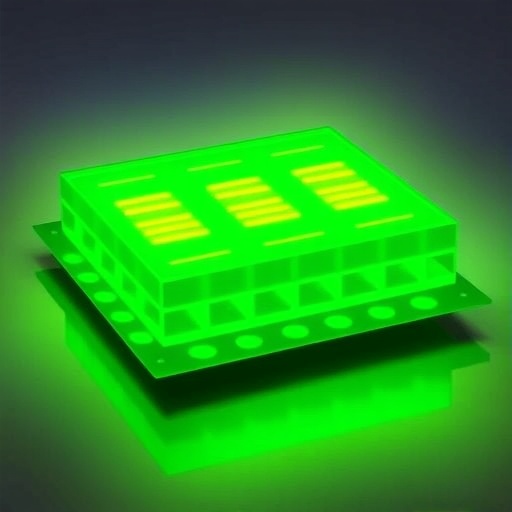Organic solar cells (OSCs) have transitioned from a niche scientific curiosity to a promising alternative in the realm of photovoltaic and photodetection technologies. Over the past four decades, tremendous advances in material design and synthesis have propelled OSCs closer to practical application, especially for photodetectors. Unlike their inorganic semiconductor counterparts, OSCs offer an enticing combination of mechanical flexibility, broad spectral sensitivity extending from ultraviolet (UV) to near-infrared (NIR), lightweight construction, and straightforward fabrication processes. These advantages position OSCs as potential game-changers in wearable optoelectronics, medical diagnostics, optical imaging, spectrometry, and light communication systems.
Despite these attractive qualities, OSCs face significant hurdles, particularly when scaling up to large-area devices. Their intrinsic structural disorder and the excitonic nature of charge carriers introduce challenges that slow the path toward performance benchmarks competitive with inorganic semiconductor (ISC) devices. Recent research efforts have focused on addressing critical performance metrics such as responsivity, detectivity, and stability, as depicted in state-of-the-art evaluations of organic photodiodes. These metrics define the practical viability of organic photodetectors (OPDs) in demanding applications.
One of the limiting factors in mass production stems from the thermal instability of most organic materials. These compounds often degrade or lose their semiconducting properties when subjected to the high-temperature post-processing steps common in semiconductor manufacturing or long-term moderate temperature operation. Innovations in modifying the buffer layers within photodetectors have garnered significant attention as a means to enhance device durability, efficiency, and sensitivity. By engineering stronger charge-blocking interfaces and optimizing hole extraction layers, researchers have demonstrated measurable gains in operational stability and device performance.
A particularly promising strategy involves doping the interface layers. This approach effectively modulates the energy band alignment at critical junctions, facilitating charge transport and reducing recombination losses. Increasing doping concentrations in these layers has emerged as a reliable lever to boost OSC photodetector efficiency, thereby narrowing the performance gap with conventional inorganic alternatives. However, balancing doping levels without compromising device stability remains a complex engineering challenge requiring further exploration.
From an ecological perspective, OSCs hold significant promise over traditional inorganic semiconductors. Their fabrication typically demands less energy-intensive processing and uses more abundant, environmentally benign materials. Still, the intrinsic properties of OSCs — particularly their limited carrier mobility resulting from weak intermolecular interactions — impose fundamental performance constraints. This phenomenon manifests as slower charge transport, reduced carrier lifetimes, and ultimately lower signal-to-noise ratios compared to materials like silicon, germanium, or indium gallium arsenide (InGaAs).
Organic photodetectors can operate under various modalities, including photoconductive, photovoltaic, and field-effect transistor (FET) types. Yet, the dominant commercial approach remains the simple organic photodiode. While individual photodiodes exhibit promising characteristics, the realization of high-yield, reproducible, and scalable two-dimensional arrays remains elusive. The fabrication of uniform, stable pixels on large-area substrates is essential for integration into commercial imaging systems, but efforts so far have fallen short of industrial standards.
The intrinsic physical properties of organic materials impose inherent limitations that are not easily circumvented. Parameters such as carrier mobility, absorption coefficients, and carrier lifetimes define the operational limits of organic photodetectors. Although OSC materials exhibit ultra-high absorption coefficients, typically around 10^5 cm⁻¹, these optical advantages do not compensate for their relatively short carrier lifetimes when benchmarked against conventional semiconductors. This disparity results in effective photodetector performance that, while competitive in some aspects, cannot outperform traditional materials in many critical metrics.
Detectivity — a key figure of merit quantifying a photodetector’s ability to discern weak optical signals — has been a subject of intense scrutiny in organic devices. Current assessments indicate that the maximum detectivity of OSC photodiodes achieves levels comparable to typical ISC photodiodes, but with considerable variation spanning nearly three orders of magnitude. Reports claiming detectivity values exceeding 10^14 Jones are often subject to overestimation due to unrealistic assumptions or measurement inaccuracies.
More advanced organic phototransistors show apparent potential to surpass the theoretical shot-noise-limited performance floor (SFL/BLIP), but these claims often arise from inconsistent parameter choices or experimental artifacts. Such discrepancies underscore the pressing need for standardized measurement protocols and comprehensive physical modeling to validate performance claims reliably.
A critical challenge that remains is translating the promising laboratory-scale device performance into the context of real-world applications. Large-area device fabrication demands homogeneous material deposition processes, consistent doping levels, and minimal defects to ensure reproducibility and scalability. Presently, these conditions are difficult to maintain for OSC-based arrays, which limits their commercial deployment in imaging and sensing applications requiring high pixel uniformity.
Furthermore, the operational stability of organic devices under ambient conditions is a concern. Exposure to moisture, oxygen, and photochemical degradation can rapidly deteriorate performance, posing a significant barrier to long-term device usability. Protective encapsulation and intrinsic material stabilization strategies are active research areas that aim to overcome these practical limitations.
In conclusion, while organic photodetectors exhibit a unique combination of flexibility, tunability, and ecological benefits that could revolutionize optoelectronic applications, material limitations and manufacturing challenges constrain their widespread adoption. Leveraging interface engineering, advanced doping, and improved fabrication techniques will be crucial to bridging current performance gaps. As understanding of organic semiconductor physics deepens and processing technology matures, OSC-based photodetectors are poised to become viable complements—if not alternatives—to traditional inorganic devices in specialized markets.
The evolving landscape of organic photodetectors exemplifies the delicate balance between innovative material science and pragmatic device engineering required to realize next-generation optoelectronic components. Continued multidisciplinary research integrating chemistry, physics, and engineering is essential to unlock the full technological promise of OSCs for practical, large-area, high-performance applications.
Subject of Research:
Peculiarities and performance potentials of room temperature organic photodetectors, particularly organic photodiodes, in comparison with conventional inorganic semiconductor photodetectors.
Article Title:
Peculiarities of room temperature organic photodetectors.
Article References:
Rogalski, A., Wang, J., Wang, F. et al. Peculiarities of room temperature organic photodetectors. Light Sci Appl 14, 359 (2025). https://doi.org/10.1038/s41377-025-01939-2
Image Credits:
AI Generated




